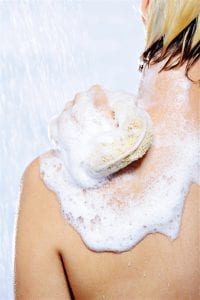Do you often wonder if you smell? Are you one who NEVER leaves home without a heavy coat of deodorant under your armpits? If so, take note…
The ABC’s of B.O.
Being conscious of your stink factor starts early on in middle school. This is when you sit through the prepubescent talks about the inevitable biological changes that will soon take place, such as emitting a new and rather objectionable body odor.
Companies have used these classroom lessons as an opportunity to promote their deodorants by providing product samples and coupons to preteens. But unless you’re told otherwise, you probably assumed these products are safe.
Here’s what you need to know about minimizing your unique essence, deciphering deodorant ingredients, and being a smart consumer.
How Chemicals Enter Your Body
Hair follicles (small ducts containing the hair shaft) and sweat pores are open entryways to chemicals. Areas of the body that are particularly hairy (e.g., the underarms) and have higher concentrations of sweat pores (e.g., under the arm) are most easily penetrable by chemicals.
 Once chemicals enter the body and penetrate the deeper layer of the skin, they’re distributed via the bloodstream where they may exert their effects far from the original point of entry. Transdermal patches are effective because they deliver medication through the skin and into the bloodstream.
Once chemicals enter the body and penetrate the deeper layer of the skin, they’re distributed via the bloodstream where they may exert their effects far from the original point of entry. Transdermal patches are effective because they deliver medication through the skin and into the bloodstream.
“Safe” Until Proven Toxic
Deodorants (classified as cosmetics) are considered safe only until they’re proven toxic. Until a chemical is tested and evaluated for toxicity or if the results aren’t publicly available, current laws recognize the chemical as safe. Thousands of chemicals are considered “safe” because the government agencies cannot address the hazards associated with all of them.
Who’s Watching Over the Deodorants?
 Cosmetic products and their ingredients are not reviewed or approved by the FDA before they’re available to the public. (Color additives and a few prohibited ingredients are the exception.)
Cosmetic products and their ingredients are not reviewed or approved by the FDA before they’re available to the public. (Color additives and a few prohibited ingredients are the exception.)
Even with inadequate or no critical data to assess the health hazards, manufacturers can sell their product without government approval.
The FDA can only take regulatory action to remove an adulterated or misbranded deodorant AFTER it’s released to the marketplace. They also have no authority to “order” the recall of a cosmetic and can only make a request. Cosmetic companies may report data on their establishments, product ingredients, and related injuries to the FDA on a voluntary basis.
Banned Ingredients
Coumarin (1, 2-benzopyrone) is a chemical compound used in deodorants and perfumes. It has a sweet smell of freshly cut grass or hay and is found naturally in plants, but can be synthetically produced as well. This substance has a vanilla-like flavor and was banned as a food additive in the U.S. in 1954 largely because it causes liver damage in rodents.
Coumarin is used to derive warfarin (Brand name: Coumadin), a drug that prevents the abnormal formation and migration of blood clots. Per the Coumarin MSDS, this substance is:
- Extremely hazardous if ingested
- Hazardous if inhaled
- Slightly hazardous to the skin (irritant)
- Possibly carcinogenic for humans by IARC
- Possibly mutagenic, teratogenic, and developmentally toxic since effects are not available
Since deodorants and antiperspirants are slathered on the skin, the following data should be of concern. According to the International Agency for Research on Cancer (IARC):
“Coumarin is rapidly and extensively absorbed after topical or oral administration to human subjects. It undergoes very extensive metabolism along two major pathways. The target organs for coumarin toxicity are primarily the liver in rats and the liver and lung in mice.”
What’s Making that Smell?
You may prefer a particular deodorant because of its fragrance, but beware. Fragrance manufacturers are NOT required to identify chemical contents and  they may only list “Fragrance” as an ingredient.
they may only list “Fragrance” as an ingredient.
There are over 5,000 fragrance chemicals used in the industry. One fragrance may consist of hundreds of synthetic ingredients — many of which are volatile petrochemical compounds.
Fragrance-Free – Is It Really?
Commercial “fragrance free” or “unscented” products are rare and may only mean they have no discernible scent. Companies may add a masking fragrance to a product to conceal the odor of its raw ingredients without adding a detectable odor to it.
Potential Acute and Chronic Effects
Deodorant ingredients often include propylene glycol and butylene glycol which are derived from petroleum. The MSDS (Material Safety Data Sheet) reports propylene glycol:
- May be toxic to the central nervous system (CNS).
- Can produce target organ damage with repeated or prolonged exposure to the substance.
Per the butylene glycol MSDS, this chemical is combustible and may cause:
- Eye irritation
- Kidney damage
- Cardiac disturbances
- Central nervous system effects
- Skin and respiratory tract irritation
Antibiotic Exposure

Triclosan, an antibiotic, is also a common ingredient in:
- Deodorants
- Deodorant soaps
- Liquid hand soaps
- Hand sanitizers
In the attempt to create germ-free environments, anti-microbial products are now suspects in the emergence of bacterial strains that are insensitive to these antiseptics and resistant to antibiotics. Evidence also indicates that long-term use of these products may cause skin alterations.
Cleaning Up
 If you sweat a lot and/or exercise regularly, you’re likely more vulnerable to marketing messages geared to combat sweat.
If you sweat a lot and/or exercise regularly, you’re likely more vulnerable to marketing messages geared to combat sweat.
Showering daily will help control the bacteria. But you have to wash thoroughly with soap and water and rinse well.
Soap attaches to dirt. If you don’t rinse off all the soap, you just end up with dirty soap residue on your skin.
Sweat is odorless. It’s when sweat mixes with bacteria and ferments that it smells.
![]() Karen’s Fit Tip: Instead of relying on masking agents and antibiotics to smother and kill bacteria, keep your skin (and your clothes!) clean. Remember, Sweat + Bacteria = B.O.
Karen’s Fit Tip: Instead of relying on masking agents and antibiotics to smother and kill bacteria, keep your skin (and your clothes!) clean. Remember, Sweat + Bacteria = B.O.
Shower daily with a CLEAN washcloth (and scrubby), and lather up with a natural tea tree oil* soap, then rinse, rinse, rinse!
*Tea tree oil is derived from the leaves of the Australian tea tree. It is known for its anti-fungal and antibacterial properties.


